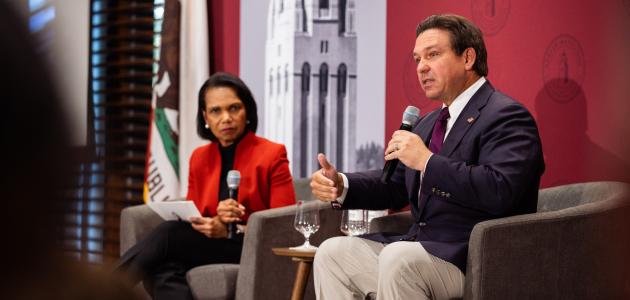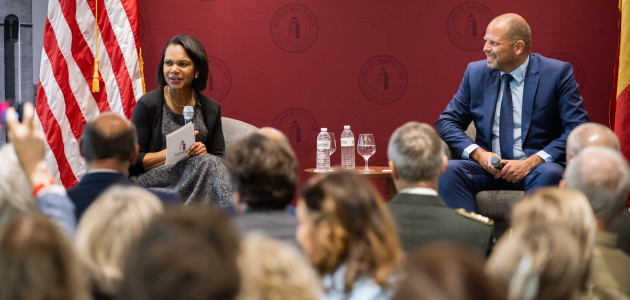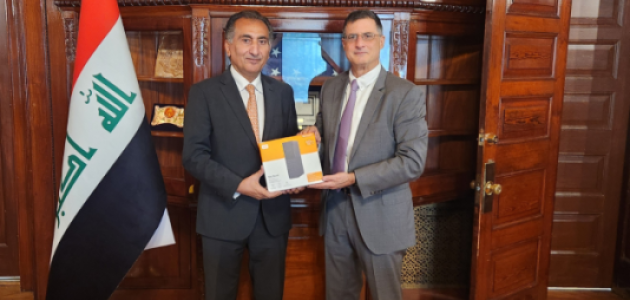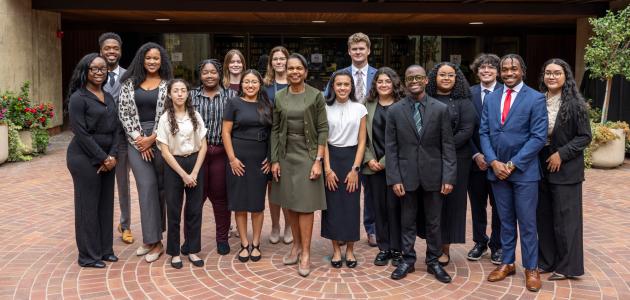The symposium “Building on Success: The Soviet Dissident Movement and American Foreign Policy during the 1980s” brought together former Soviet dissidents, scholars, and policy makers to discuss the methods employed by Soviet dissidents and their Western supporters that contributed to the end of the communist rule of the former USSR. The Hoover Institution hosted the event on April 14.
The symposium opened with remarks by former U.S. secretary of state George P. Shultz, the Thomas W. and Susan B. Ford Distinguished Fellow at the Hoover Institution, who said it was an opportunity to “look back at some of the really seminal, important events we had and see what we can learn from them.”
He discussed aspects of the dissident movement that struck him, saying that he was inspired by the immense personal courage of the dissidents. “If you went there thinking you were going to try to help them, you go away feeling they helped you realize what personal courage is really all about,” Shultz said, adding that there must be, around the world, people and significant institutions who work at and care about overcoming totalitarianism.
Shultz spoke of President Ronald Reagan’s approach to the Soviets, which called for the end of the Soviet Union. The use of détente and linkage in dealing with oppressive governments prevents working at the problem, Shultz said, calling for continuous engagement with the governments in question.
The most compelling aspect of service for him, the greatest accomplishment, came down to a human being, Shultz said, as he recalled assisting a woman named Ida Nudel in emigrating from the Soviet Union to Israel. One wonderful day he heard a voice on the phone say, “This is Ida Nudel, I'm in Jerusalem. I'm home.”
Yuri Yarim-Agaev, a distinguished visiting fellow at the Hoover Institution and former Soviet dissident, organized the conference, which he described as an opportunity for “participants to examine basic guiding principles of dissident groups and consider whether their successful experience could be applied to solving problems with current totalitarian regimes.”
In the session “Toppling Totalitarianism—The Sakharov-Reagan Model,” Yarim-Agaev said that the end of the Soviet communist government was secured by three major forces: internal dissidents, Western democratic governments, and western nongovernmental organizations, including media and cultural and academic communities. He suggested that during that period the new Sakharov-Reagan Model emerged.
Yarim-Agaev outlined the basic guiding principles for the three major forces and the two stages—first, toppling totalitarianism government and, second, building democracy (see the model at /sites/default/files/uploads/inline/docs/Sakhrarov-Reagan_model.pdf). He elaborated on the principles that guided dissidents, emphasizing among them nonviolent resistance to a violent regime.
The methods used by Western governments and nongovernmental organizations (NGOs) to undermine the authority of the Soviet , communist government were discussed by Mark Palmer, chief executive director, Capital Development, and the U.S. ambassador to Hungary from 1986 to 1990, and Philip Siegelman, professor emeritus, political science department, San Francisco State University, in the same session. Palmer suggested that it’s important to remember that the dissidents aren’t supported by the United States alone. “We need to find ways to work with others to support dissidents,” he said. Yarim-Agaev was the panel moderator.
Richard Perle, American Enterprise Institute fellow, Vladimir Bukovsky, writer and human rights activist and former Soviet dissident, and David Waksberg, executive director, Bureau of Jewish Education of San Francisco and former vice president, Union of the Council on Soviet Jewry, discussed approaches to supporting democratic government in the “Second Stage: Building Democracy in a Post–totalitarian World.” Perle said he appreciated the emphasis on dissidents; their courage inspires others and their courage achieves victories. He added that “the seminal fight is for human rights, the democracy will follow.” John Dunlop, Hoover senior fellow and acting director of the Center for Russian, East European, and Eurasian Studies, Stanford University, was the session moderator.
The feasibility of applying the Sakharov-Reagan Model to other countries was examined by Henry Rowen, Hoover senior fellow, and Charles Wolf, Hoover senior research fellow and distinguished chair in international economics and senior economic adviser, Rand Corporation, in “Present Day: Can We Apply This Model to Current Situations?” In his remarks, Wolf discussed the strengths and weaknesses of the model, noting the influence of dissidents but raising questions about other factors, such as the economy, that affect countries. Michael McFaul, Peter and Helen Bing Senior Fellow, Hoover Institution, and director of the Center on Democracy, Development, and the Rule of Law, Freeman Spogli Institute, Stanford University, was the moderator.
Yarim-Agaev provided the keynote address, “A Conspiracy of Dissidents,” at the symposium dinner. “At some moment of history, in very different places, both inside the communist world and in free democratic countries, the people of a very similar and special spirit emerged—dissidents,” he said. “No one ever coordinated their actions, yet there was so much common in their vision, characters, and philosophy that they acted with a great mutual understanding and support.” Yarim-Agaev included in this circle of dissidents not only traditional names, such Andrei Sakharov and other Soviet human rights activists, but many leaders of Western NGOs and democratic governments of that time, including Ronald Reagan.













